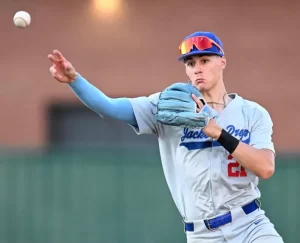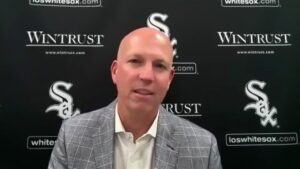White Sox Draft Primer: Will the “Best Player Available” be a prep prospect?

When gearing up for the MLB draft, the Scouting Director has about a two-month period of media attention. Given the ambiguity required of the draft process, the quotes from your top scouts are limited. So when a team’s beat writers get their sound bites from the Scouting Director du jour, you will hear the same thing from just about any team: “We are going to take the best player available.” The White Sox, and their first year Scouting Director Nick Hostetler, are no exception to that rule. When they officially promoted Nick Hostetler to be their Scouting Director last August, his initial conference call with the media yielded that same type of rhetoric.
I had the fortune of interviewing Hostetler shortly after his promotion became official last August and in our conversation, he echoed that same sentiment more than once. When Hostetler alluded to the initial media reception acknowledging the fact that he’s not afraid to draft high school prospects, Hostetler added this caveat, “In terms of me personally, we’re not going to switch and go high school, high school, high school. I am big believer in best player available.” He added on with the idea by pointing to the recent White Sox first round draft picks, “We haven’t used those picks on bats recently. Rodon, Fulmer and those guys were the best players available. I definitely think that Tim Anderson was too.”
Putting Hostetler aside, and looking back at the White Sox recent draft history, you’ll see a certain pattern. While team officials have acknowledged past selections haven’t always been representative of the “best player available,” this was primarily due to financial corollaries in a past collective bargaining agreement (CBA) that have since been quashed by the MLB owners. Nonetheless, as the CBAs have reformed and the draft strategies changed, the pattern still held true.
This is not to say the White Sox are averse to drafting from high school as a whole, but you do have to go all the way back to June of 2001 to find when the White Sox had last drafted a high school pitcher by selecting Providence Catholic’s Kris Honel. As far as bats, you only have to go back to 2013 when they selected Courtney Hawkins but other than Hawkins, they haven’t selected a prep bat with their first selection since 1994 when they took former catcher Mark Johnson. Not to mention, Honel never even made it to AAA and Hawkins has yet to reach that level himself.
In any case, what constitutes the “best player available?” Is it solely a proprietary evaluation of the potential value the player could offer in the Major Leagues? Is it the highest overall grade available from your scouts? And when you’re looking at a team like the White Sox especially, where does risk fall into the equation? With the way the slotting system has facilitated more of a financial implication to the draft process, do you always take the best player available? Or do you take the best value, which in turn, enables you to come away with the best group of players?
The answers to these questions are all understandably subjective and will vary from team to team. All things considered, it is fair to assume the White Sox value the lesser risk associated with college prospects as opposed to the risk connected to high school prospects. How else would a team end up with their first pick being a college guy in fourteen of the last sixteen drafts?
With this pattern in mind, the pundits and evaluators who go through the laborious task of releasing a mock draft typically get to the White Sox, consider the lack of information they have been given from the tight-lipped organization, and say, “The White Sox typically go college arm so ‘blank’ makes sense here.” In this particular draft, we will be seeing a lot of Mississippi State’s Dakota Hudson being mocked to Chicago.
The emphasis on the draft has certainly changed since Rick Hahn has taken over as General Manager. But still, the White Sox have had the best performing college pitcher fall into their laps in back-to-back years in Carlos Rodon and Carson Fulmer. Picking at #3 and #8 respectively, those picks both seemed to be great value, and the pattern perpetuated.
Looking back at the 2014 draft in particular, you can learn a bit more about the thinking attached to the process. If you were watching the Sox games during the first week of June in 2014, you might remember that announcers Steve Stone and Hawk Harrelson completely eviscerated the prospect of drafting a high school pitcher with #3 pick. At the time, it was consensus view that Brady Aiken, Carlos Rodon and Tyler Kolek were the three best prospects of the draft. Stone and Harrelson spoke on the weighty risk along with unlikelihood that an 18 year old throwing in the upper 90’s could hold his value through his infancy professional years. To their credit, the two pitchers they were speaking of, namely Brady Aiken and Tyler Kolek, have since had to get to Tommy John Surgery.
Here at Future Sox, we had learned that the White Sox were never going to take a high school arm in the first round of that draft. They knew Aiken would go to the Astros at #1 and while they were unsure of what the Miami Marlins would do at #2, they were never going to draft the 18-year-old flamethrower Tyler Kolek. They would be taking either Carlos Rodon or Philadelphia’s right-hander Aaron Nola, with Rodon obviously being the preference. Furthermore, in that draft and at that pick, the White Sox had options for college arms that they could be excited about.
The 2015 draft process generated a similar result. If Carson Fulmer had not made it to pick #8, the White Sox had an understanding of what it would take to sign Louisville’s Kyle Funkhouser as a contingency. So in both 2014 and 2015, there wasn’t anything other than a college pitcher considered as the draft played out.
Coming to the present, the 2016 draft offers a stark contrast. As opposed to the past two drafts, the college crop of pitchers in 2016 is probably the worst in recent memory. The college hitters, while showing more promise than the arms, are still far from an elite draft class. In case you weren’t aware, the White Sox have the 10th, 26th and 49th pick in this upcoming draft, giving them an unusual and advantageous three picks among the top 50.
So taking the White Sox past tendencies, parsing them against the crop of prospects and the current slating of prospects in mock drafts, it seems very likely there will be slim pickings for college prospects at pick #10. While no one can get a gauge on what the Phillies are doing at #1, the Reds (#2), Braves (#3) and Athletics (#6) are all expected to take college bats. If things stay largely the same, your first tier of college bats in Louisville’s Corey Ray, Tennessee’s Nick Senzel and Mercer’s Kyle Lewis could all be off the board before the White Sox could even garner hope that one falls to them. Even if your consensus top college pitcher in AJ Puk were to take a tumble, I’d be hard pressed to see him get past the Tigers with their draft mentality of selecting power-abundant assets.
So where does that leave the White Sox? It would be underwhelming if they were hoping that the de facto second best college pitching prospect in Dakota Hudson could fall to them. It’s hard to imagine any of Puk, Ray, Lewis, Senzel, Jason Groome or Puerto Rican shortstop Delvin Perez falling to pick #10. After those six, the best remaining prospects (in no particular order) include the following: OF Mickey Moniak, OF Blake Rutherford, RHP Riley Pint, P/1B Joey Wentz, INF Nolan Jones, LHP Braxton Garrett, RHP Matt Manning and the aforementioned Hudson. Other than Hudson, every one of those prospects is of the prep variety.
The White Sox do hold the option of choosing a college player and potentially signing them under-slot. The extra draft slot (the Sox pick at 26th also) makes this an even more intriguing option, if they can steal a “signability” player with that second pick. So if you see the White Sox picking a “reach” at 10, keep that extra pick in mind.
One guy who could emerge as the popular pick in this regard as the draft comes closer is University of Miami’s catcher Zack Collins. He will draw comparisons to Kyle Schwarber given his advanced bat and lack of likelihood to stick behind the plate, but he doesn’t have the power potential of the Cubs slugger. But at the same time, Keith Law has intimated Collins as a potential pick for the A’s at #6 and his current helium could keep propelling him higher in a draft with a scarcity of refined bats. Another guy who could potentially fit this bill is Vanderbilt’s outfielder Bryan Reynolds.
To reiterate, we are still a ways off from the draft and this is only a snapshot in time in what is always a protean process. You can be sure the White Sox will have contingencies in place that involve selecting a high school player at #10, as they almost have to. Drafting a prep prospect would go outside of what has become an abiding track record, but if the team holds true to the philosophy of drafting the “best player available”, they just may have to buck that trend.
***As always you can follow us on Twitter @FutureSox. Our draft coverage will continue and only ramp up as we move closer to Draft Day 2016.
Want to know right away when we publish a new article? Type your email address in the box and click the “create subscription” button. Our list is completely spam free, and you can opt out at any time.






